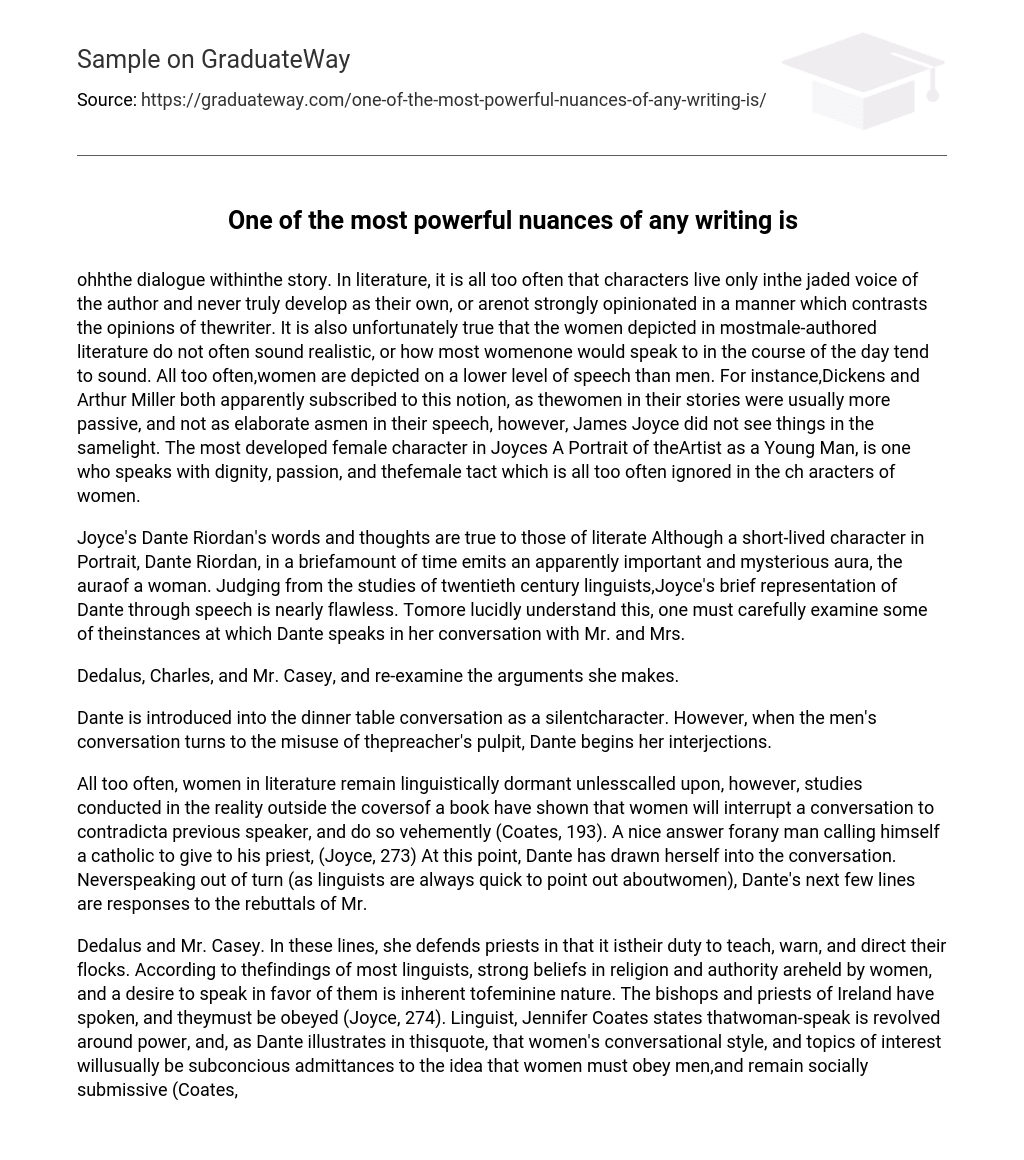In literature, it is all too often that characters live only inthe jaded voice of the author and never truly develop as their own, or arenot strongly opinionated in a manner which contrasts the opinions of thewriter. It is also unfortunately true that the women depicted in mostmale-authored literature do not often sound realistic, or how most womenone would speak to in the course of the day tend to sound. All too often,women are depicted on a lower level of speech than men.
For instance,Dickens and Arthur Miller both apparently subscribed to this notion, as thewomen in their stories were usually more passive, and not as elaborate asmen in their speech, however, James Joyce did not see things in the samelight. The most developed female character in Joyces A Portrait of theArtist as a Young Man, is one who speaks with dignity, passion, and thefemale tact which is all too often ignored in the ch aracters of women.
Joyce’s Dante Riordan’s words and thoughts are true to those of literate Although a short-lived character in Portrait, Dante Riordan, in a briefamount of time emits an apparently important and mysterious aura, the auraof a woman. Judging from the studies of twentieth century linguists,Joyce’s brief representation of Dante through speech is nearly flawless. Tomore lucidly understand this, one must carefully examine some of theinstances at which Dante speaks in her conversation with Mr. and Mrs. Dedalus, Charles, and Mr. Casey, and re-examine the arguments she makes.
Dante is introduced into the dinner table conversation as a silentcharacter. However, when the men’s conversation turns to the misuse of thepreacher’s pulpit, Dante begins her interjections. All too often, women in literature remain linguistically dormant unlesscalled upon, however, studies conducted in the reality outside the coversof a book have shown that women will interrupt a conversation to contradicta previous speaker, and do so vehemently (Coates, 193). A nice answer forany man calling himself a catholic to give to his priest, (Joyce, 273) At this point, Dante has drawn herself into the conversation. Neverspeaking out of turn (as linguists are always quick to point out aboutwomen), Dante’s next few lines are responses to the rebuttals of Mr. Dedalus and Mr. Casey.
In these lines, she defends priests in that it istheir duty to teach, warn, and direct their flocks. According to thefindings of most linguists, strong beliefs in religion and authority areheld by women, and a desire to speak in favor of them is inherent tofeminine nature. The bishops and priests of Ireland have spoken, and theymust be obeyed (Joyce, 274). Linguist, Jennifer Coates states thatwoman-speak is revolved around power, and, as Dante illustrates in thisquote, that women’s conversational style, and topics of interest willusually be subconcious admittances to the idea that women must obey men,and remain socially submissive (Coates, 203).
Joyce’s realistic portrayal of Dante does not end there, however. Instudying the findings of linguists, it becomes clear that during theRenaissance, it was proper for a woman to be silent and a man to beeloquent. However, the increased level of female literacy in the latenineteenth and early to present twentieth century, changed this philosophy,and it is now expected that women be just as, if not more eloquent thanmen. As Dante continues her conversation, she quotes the Bible in responseto the ongoing attacks of the men at the dinner table in the presence ofwomen and a child: Woe be to the man by whom the scandal cometh! It wouldbe better for him that a millstone were tied about his neck and that heshould scandalise one of these, my least little ones. (Joyce, 274)
Even today, it is rare in literature to find a woman allude to, let alonedirectly quote literature as a witty response to a verbal assault. Womenhave an instinctive shrinking from coarse and gross expressions and apreference for refined and (in certain spheres) veiled and indirectexpressions (Coates, Jesperson, 126).
What better way is there to describeDante Riordan? Her primary reason for involving herself with theconversation from the start is the vile blasphemy at hand. Of her sixteenturns in the conversation, eight of them are devoted to reprimanding the’language’ that she hears from the mouths of the men. To assert the realityof Dante’s character even further, look to sociolinguist William Labov. Hewrites that, in lower and middle-class groups, females are far lesstolerant of incorrect grammar and taboo (Labov, 207).
This was madepleasantly lucid in the character of Dante Riordan. In light of all ofthis, it steadily becomes more apparent that Joyce had paid carefulattention to real conversational language. In the characters of the men, hecaptured the competitive attitudes, vulgarity, and lack of tact which areso often marks of men in English speaking societies.
But more importantly,through the character of Dante, he captured the fire, the respect, thesubconscious submission, and the maternal aversion for taboo that unite toform the psyche of this century’s woman. Joyce, in spite of his hatred ofthe church, designed a character who’s few spoken words do all they can touphold the honor of the imperfect institution, and aside from Mr. Dedalus’sfinal immature remark, Dante has the last word, and in effect wins theconversation. This is literary genius.
Developing thoroughly andrealistically the character of a non-existent person in the medium of textalone is a monumental task, but one that appears so effortless in Joyce’sportrayal of Dante. A problem re mains, however where are all of the otherreal women in dead white male literature.
Reference
- Bloom, Harold. Modern Critical Interpretations: James Joyce’s A Portraitof the Artistas a Young Man. New York:Chelsea House Publishers, 1988.
- Coates, Jennifer. Women, Men and Language. New York:Longman, 1993.
- Labov, William. Variation in Language in Reed, C.E.O The Learning of Language. National Council of Teachers of English, New York, 1971.





